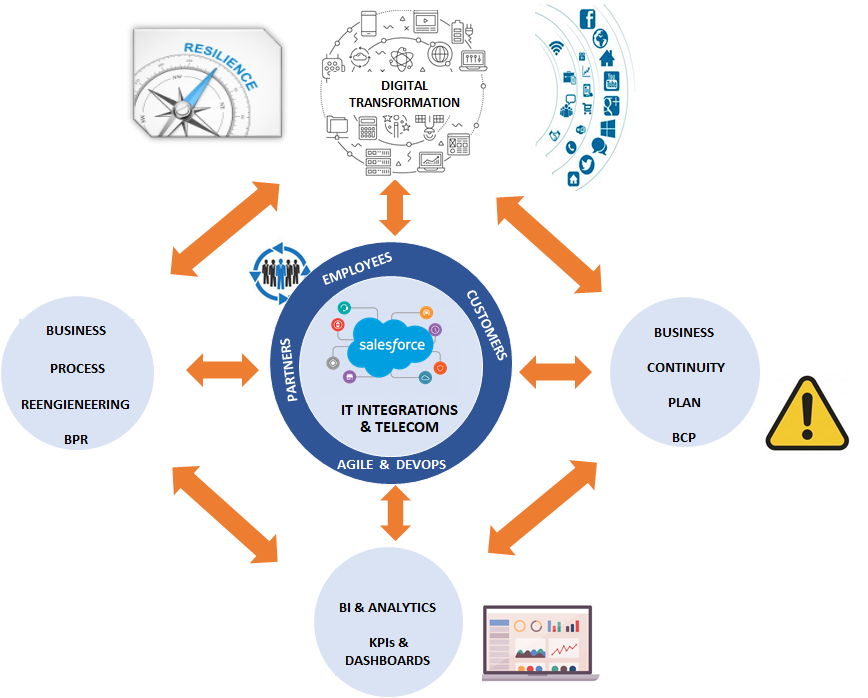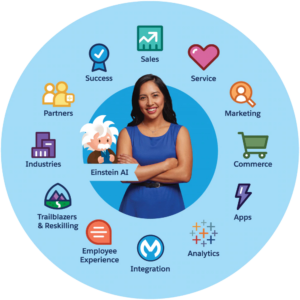Salesforce and the resilient digital transformation

We are frequently facing or immersed in digital transformation projects or another kind of technological projects, where in addition to aligning them with strategic plans and platforms – chosen systems-, we also have to consider other exogenous factors, like the one we have recently lived (COVID-19). In cases like this, companies, employees and clients additionally demand that those transformational programmes must be resilient to any type of vulnerabilities or adversities, which should be better prepared and minimize its potential impact.
It is the client who demands organizations to have a closer approach, transparency, better information, accessibility and self-service. They demand a homogenous and coherent service provided through different channels, and a better continuity of their operations, either through the more traditional channels or through digital channels.
We keep watching an increase in the use and demand of digital channels, with a migration as well from offline channels to digital ones. This fact creates and increment in the necessity of aggregation and integration of multiple sources and information formats from the different business processes, into global and unified CRMs. Besides that, audience data management platforms – DMP and digital multichannel marketing platforms-, are also needed in order to give us visibility and analytic insights from all the customer journey of our clients, which will measure and provide a better knowledge of the attraction and loyalty processes, brought together with reliable and quality information.
Although the request for improvements and integrations in the information systems and in the CRM of organizations is common, they have been amplified in the last months as a consequence of changes in sales processes, channels, and greater digitization and automation of business processes.
Generally, we have seen that this situation has helped to accelerate and/or reinforce the plans of digital transformation of organizations (manufacturers, services, governmental and non-profit organizations). We have also perceived a greater integration and openness of supply chains and internal processes with other external, creating demand networks which are more interconnected and digital.
One of the enablers of this digital transformation are Cloud platforms / SaaS, because they allow a shorter ‘time to market’ in the provision of information systems.
Alongside with the use of agile and iterative methods, they enable fast and incremental prototypes, assuring a better protection and return of the investment.
In addition to the fundamental role that a CRM has in digital transformation projects, so too do the systems integration architecture, data centers and cloud computing service providers – PaaS and IaaS, the correct orchestration of public, hybrid and private clouds, and good systems continuity and telecommunications plans.

Enablers
Therefore, organizations must analyse which technological models and platforms better support changes, challenges and required innovations in order to deliver a sustainable, scalable, agile, flexible and resilient digital transformation process.
Digital transformation processes should also have the following enablers, because they allow a better resilience and sustainability in time, both for the usual and planned scenarios, as well as for those not expected and adverse:

- A resilient leadership, focused on: strategic plans compliance, a better understanding of the multiple interactions and communication channels with clients, the management of expectations and experiences, and the management of people and organizational culture.
- The improvement / revision / automation of operational and business processes, and the choice of key business indicators (KPIs).
- The selection and implementation of the existing and future information systems and technological platforms, with a good alignment to business processes, and the establishment of open architectures, which will allow an increasing number of demanded integrations, for the sake of greater agility , flexibility and efficiency of processes, their reuse and better levels of self-service.
- The use of data analytics models and platforms, which will support indicators / chosen KPI monitoring, as well as being radar and guardrails in the event of a contingency of processes and / or systems.
- Existence of a business continuity plan, including telecommunications processes, systems, and infrastructure.
The basic pillars of a technological platform, in a digital transformation process, are the following:
- A layer of interaction with the client, through multiple channels (both physical and digital); with a clear trend leaning towards cloud models and self-service.
- A layer of process and systems integration.
- A layer of analytics tools, with a clear trend leaning towards the inclusion of predictive functionalities and artificial intelligence.
- Data quality and data as the only true source.
- Plans of continuity, security and disaster recovery from the platform.
When we analyse the tech platform Customer Success Platform – Salesforce.com, we observe that it is a platform with a lot of clouds or modules, thought to provide a 360 degrees experience to the client. It allows companies to support their business multi-channel processes in a resilient and efficient way, and it also improves the experience of the client and the knowledge we have about them, thanks to the following features:
- A platform that is one hundred percent cloud-based, safe, scalable, open, flexible, it works on several operating systems; but also has periodic updates and constant innovation.

- This platform has a series of modules or clouds which occupy leadership positions in the quadrants of the tech analysts Gartner and Forrester (2020), which allow, for example:
- The automation of sales teams and commercial processes (Sales Cloud).
- The automation of customer service and customer support (Service Cloud).
- The automation of multi-channel digital marketing campaigns, organizing, planning and measuring customer interactions (B2B / B2C) via web, social networks, email, mobile, contact center, payment methods, etc. (Marketing Cloud), together with data management and audience intelligence platforms (DMP Krux and Datorama).
- The integration of e-commerce sites (B2B/B2C) with all the remaining modules and digital channels, which allows the creation of offerings, catalogues, customized prices, shopping carts and customized messages (Commerce Cloud).
- The creation and customization of self-service portals for retailers, sale points and clients, with access to certain information and files, frequent answers, and the creation and follow-up of cases (Community Cloud).
- The access and integration of any data / process within the organization, or any other external system (ERP, Data warehouse, legacy systems, etcetera.), thanks to the platform and the integration network of
- To have a business intelligence and comprehensive data analytics platform, with multi-format data models, diverse origins, descriptive and predictive models, and friendly interfaces that allow a good dose of self-service and democratization of data to users and clients. (Tableau).
- The development of customized applicatoins, with the development tools Platform and
- A very flexible and open platform, with integration between its clouds, and with other private and public clouds.
- The functionality of an intelligent assistant (Einstein), which can help with interactions between employees and customers.
- An ecosystem with numerous partners, certified consultants and developers.
- A foreseeable economic model, based on a subscription model, where investment varies depending on the number of users and the existing necessities.
- It aligns with any continuity plan and makes contingency plans more flexible.
- Creates notable increases in productivity and return of investment, as well as a good adoption from users and customers.

Conclusions
In order to execute a sustainable and resilient transformation plan, it is necessary to address these processes with a wider vision where we should include these enablers or accelerators to support both personal and organizational resilience. Without any doubt, salesforce.com is an enabler of this resilient digital transformation, which we must take into account in the selection and planning of the transformation and digital integration plans.
As Benajmin Franklin said, “If you fail to plan, you are planning to fail”, and within that planning, we must contemplate the digital transformation Project, as well as the rest of enablers.
And of course, in addition to the analysis of processes, transformation plans and business continuity, technologies and systems integration, etc., it is necessary to consider the human factor and have the right talent, both in the design and implementation of digital transformation processes, as well as potential incidents that may occur along the way, as well as a culture of democratization and literacy of these plans, and a good dose of innovation, positive thinking and empowerment for employees.
Did you find this article interesting? Share it!
Maybe your friends will also enjoy this.




